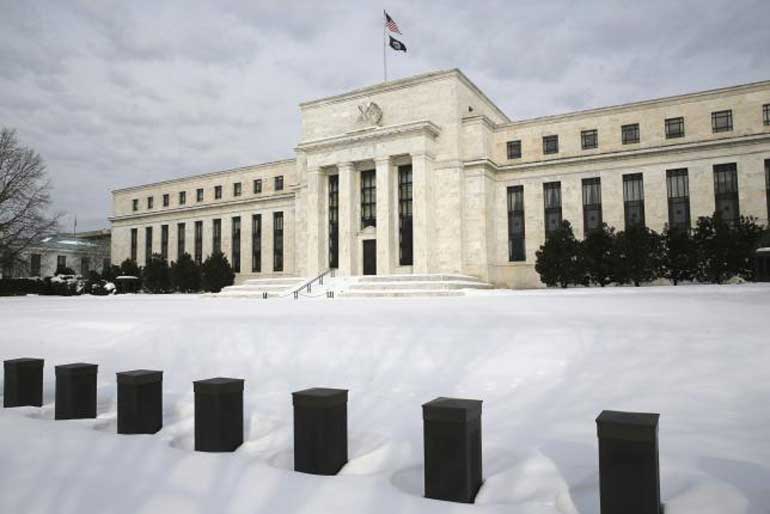Friday Dec 27, 2024
Friday Dec 27, 2024
Saturday, 30 January 2016 00:00 - - {{hitsCtrl.values.hits}}

Snow covers the grounds of the U.S. Federal Reserve in Washington January 26, 2016
Reuters: In the US Federal Reserve’s arsenal of tools the characterization of economic risks is heavy artillery, used to flag the moments when major events like the 2003 Iraq war or the near crack-up of the euro zone in 2011 make forecasting even trickier than usual.
The US central bank has now put the world on notice that the slide in oil prices and sharp slowdown in global growth may rank as one of those very shocks, capable of changing the Fed’s bias from implying a steady set of future rate hikes to one pointing to an extended pause or even a rate cut driven by stubbornly low inflation.
Coming just a month after it began hiking rates for the first time since the financial crisis, the Fed’s decision to pull the risk assessment altogether from its statement this week is “a US recession insurance policy,” said Bank of the West Chief Economist Scott Anderson.
It “opens up the door for a change in the balance of risks...and even an interest rate hike reversal at some point, should the economic and financial outlook turn out to be particularly nasty.”
It is also a capitulation of sorts, a subtle acknowledgement that events Fed officials have insisted for a year or more would prove of passing importance may be pulling the country toward a new slump.
When it raised rates in December, the Fed described risks to the United States as “balanced,” which cleared the way for the hike by positing that the economy was just as likely to outperform the Fed’s expectations as to do worse.
In place of that sanguine view, the Fed in its January statement said it was “closely monitoring” global developments to better understand how they may affect the “balance of risks” faced by the United States. Of late those global developments have been routinely negative, depressing US inflation, dragging on the real economy by holding down exports, and, of late, nipping at household wealth by triggering sharp drops in the stock market.
All of that points to the downside, and economists honed in on the omission of the risk assessment as perhaps the key change in a statement that held interest rates steady and characterized the economy as continuing to grow and produce jobs.
It doesn’t take a second rate hike as early as March off the table. Economists polled by Reuters still expect three rate hikes this year, just one less than the Fed saw last December before the plunging price of oil raised questions about how quickly inflation could recover toward the Fed’s 2% target. Even traders, who have long been expecting an even slower pace of tightening, are still pricing in at least one rate hike by the end of the year.
But Fed policymakers have now told markets: don’t be too sure, because we aren’t. The change comes after two years of saying the risks to the outlook for inflation and the labour market were nearly balanced, or actually so. The Fed used similar tweaks to the risk assessment language to signal its uncertainty around the start of the 2003 Iraq war, and to note how the rise in global financial stress in 2011 caused by the euro crisis had clouded the US outlook.
“We think this language buys them time,” JP Morgan economist Michael Feroli said in a note to clients. “This statement leaves a March move on the table, but it also highlights that the bar is fairly high for such a move.”
To Tim Duy, a University of Oregon professor who tracks Fed policy closely, the removal of the balance of risks statement could have an alternate explanation: Fed Chair Janet Yellen was unable to get policy hawks and policy doves to agree if things are looking up or down.
With headwinds from slowing global growth and lower oil prices pressing down on already too-low inflation, doves like Fed Governor Lael Brainard may have argued that downside risks have increased, he said. Meanwhile, those pushing for higher rates may have pointed to stronger-than-expected jobs growth in December that may soon push the unemployment rate below the Fed’s benchmark for full employment.
Faced with that split, Duy conjectures, she decided to “ditch the sentence,” with the hope that by March the economic data will be clear enough to break the standoff.
Fed officials are barred from speaking on policy until Friday.